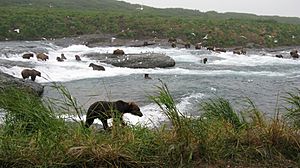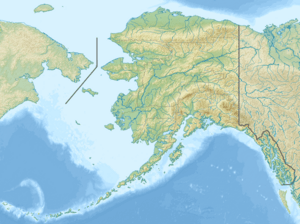McNeil River facts for kids
Quick facts for kids McNeil River Falls |
|
|---|---|

Congregation of brown bears (Ursus arctos) at McNeil River Falls
|
|
|
Location of the mouth of the McNeil River in Alaska
|
|
| Country | United States |
| State | Alaska |
| Borough | Kenai Peninsula |
| Physical characteristics | |
| Main source | Aleutian Range 1,586 ft (483 m) 58°55′48″N 154°40′04″W / 58.93000°N 154.66778°W |
| River mouth | McNeil Cove, Kamishak Bay 34 miles (55 km) southwest of Augustine Island 0 ft (0 m) 59°07′30″N 154°14′49″W / 59.12500°N 154.24694°W |
| Length | 22 mi (35 km) |
The McNeil River is a special river in Alaska, a state in the United States. It flows from glaciers and lakes in the Aleutian Range mountains. The river ends in the Cook Inlet in southwest Alaska. This river is famous for its amazing wildlife, especially its many brown bears and salmon.
Because so many animals live here, the Alaska government decided to protect the McNeil River. In 1967, it became a wildlife sanctuary. Later, in 1993, the protected area grew even larger. This area now has the highest number of brown bears anywhere in the world! Sometimes, up to 144 brown bears have been seen along the river in one summer. Once, 74 bears were even seen together in one spot. The entire 35-mile (55 km) length of the river is inside the McNeil River State Game Sanctuary. This sanctuary is part of a huge protected area that also includes Katmai National Park and Preserve.
The McNeil River is more famous for its bears than for its size or salmon. It has been shown in many TV shows and movies. Because so many people wanted to see the bears, Alaska started limiting visitors in 1973. Only ten people can visit each day during the busy summer months of June, July, and August. There are even webcams so people can watch the bears from home! Groups work to keep the area safe and free from bear hunting. The number of bears has slowly grown over the years.
Contents
Exploring the McNeil River Area
The McNeil River State Game Sanctuary and Refuge is located on the northeastern part of the Alaska Peninsula. It is next to Katmai National Park and Preserve. This special area is about 250 miles (402 km) southwest of the city of Anchorage.
How Big is the Protected Area?
The sanctuary and refuge together protect about 388 square miles (100,362 hectares) of land. About 200 square miles (51,799 hectares) are in the sanctuary part. The other 188 square miles (48,562 hectares) are in the refuge part. The McNeil River flows through the middle of the sanctuary.
What Activities are Allowed?
In the sanctuary, you can mostly do wildlife viewing and camping. All hunting and fishing are not allowed there. In the refuge, you can go fishing and sport hunting and trapping. However, hunting brown bears is not allowed in either the sanctuary or the refuge.
Getting to the McNeil River
The land in this area is mostly treeless, rolling tundra. There are also some mountains in the southern part of the sanctuary. The closest road is 100 miles (161 km) away. This means you can only get to the McNeil River by boat or floatplane. Visiting requires a lot of planning and booking ahead of time.
Amazing Animals of McNeil River
The McNeil River is home to many animals, but it is most famous for its brown bears.
Brown Bears: The Main Attraction
McNeil Falls has always been known for its bear watching. As early as 1955, it was featured in a magazine called National Geographic. It was also in a 1956 movie called The Animal World. In the 1970s, bear watching became less popular because of too many people disturbing the bears. But with better rules, the number of bears grew again.
Today, you might see as many as 100 bears at the falls in one day! It's common to see 60 or more bears at the same time. Visitors often watch bears standing at the falls, waiting to catch salmon in their mouths. Besides the main McNeil River, other places like Mikfik Creek and Chenik Lake also offer great bear viewing. Mikfik Creek and Chenik Lake are best in June, while the McNeil River is best in July.
How to Visit the Bears Safely
Visiting McNeil is not easy. To protect the bears, you must win a special lottery. This lottery allows only 10 people per day to visit McNeil for a four-day period. This strict rule helps keep the bears safe and is why so many bears live there. The McNeil Camp has cabins for rangers and places to eat. There is also a tent camp nearby for visitors.
Salmon: Bear Food
Chum salmon are the main type of salmon that bring bears to the McNeil River. About 50,000 of these salmon swim into the river system. Most of them arrive in July. The salmon are a very important food source for bears. They also feed other meat-eating animals like foxes and wolves. Bears eat mostly salmon in July. But in late August and early September, they switch to eating berries and grass. To make sure humans do not bother the bears, fishing is not allowed in the sanctuary.
Other Wildlife You Might See
Besides its famous brown bears, the McNeil River Sanctuary also has other animals. You might see moose, caribou, wolves, red foxes, wolverines, harbor seals, and bald eagles. These animals are not seen as often as the bears. But if you are patient and lucky, you might spot them!
History of Protecting McNeil River
The McNeil River has a long history of protecting its special animals and resources. This story began in the 1940s when people first discovered the area. People came to see the bears, but also to hunt and fish. Hunting bears was challenging because there were so many of them.
Early Protections and Challenges
Over the years, hunting was controlled more and more. In 1954, a visitor named Cecil E. Rhode counted 32 bears in one day. He asked the government of Alaska to stop bear hunting on the river. In 1955, all brown bear hunting was banned in the entire river area. Twelve years later, in 1967, Alaska Governor Jay Hammond signed a bill. This bill made the area the McNeil River State Game Sanctuary. The sanctuary protected about 93,000 acres, and the number of bears visiting the falls grew.
Around 1970, the number of bears started to drop again. This happened because people were getting too close to the bears. They were fishing near them and disturbing them. So, new rules were put in place in 1973. After these new rules, the bear numbers increased again. For 20 years, the bear population at the falls grew to about 60.
Expanding the Protected Area
In 1993, a plan was made to build a fish ladder in the Paint River area, only 3 miles (5 km) from McNeil Falls. A fish ladder helps salmon swim upstream. It was thought that this ladder would make about 500,000 salmon go to the Paint River. People worried that bears would follow the salmon there. This could put the bears in danger during hunting season outside the sanctuary.
To prevent this, a group called "Friends of McNeil River" took action. This led to the sanctuary being expanded to 128,000 acres. Also, a new 120,000-acre (48,562 hectare) area called the McNeil River State Game Refuge was created. Hunting was banned in the refuge in 1995.
Continued Efforts to Protect Bears
However, the challenges did not end. In 2000, the McNeil Refuge was opened to hunting again by a government board. But in 2005, it was closed to hunting once more because conservation groups pushed for it. In 2007, there was another proposal to allow bear hunting. Even with support from Alaska Governor Sarah Palin for hunting, conservationists worked hard. They finally succeeded in closing the refuge to hunting again in March 2007. That year, the number of bears at McNeil Falls reached a record high of 74!
Images for kids





